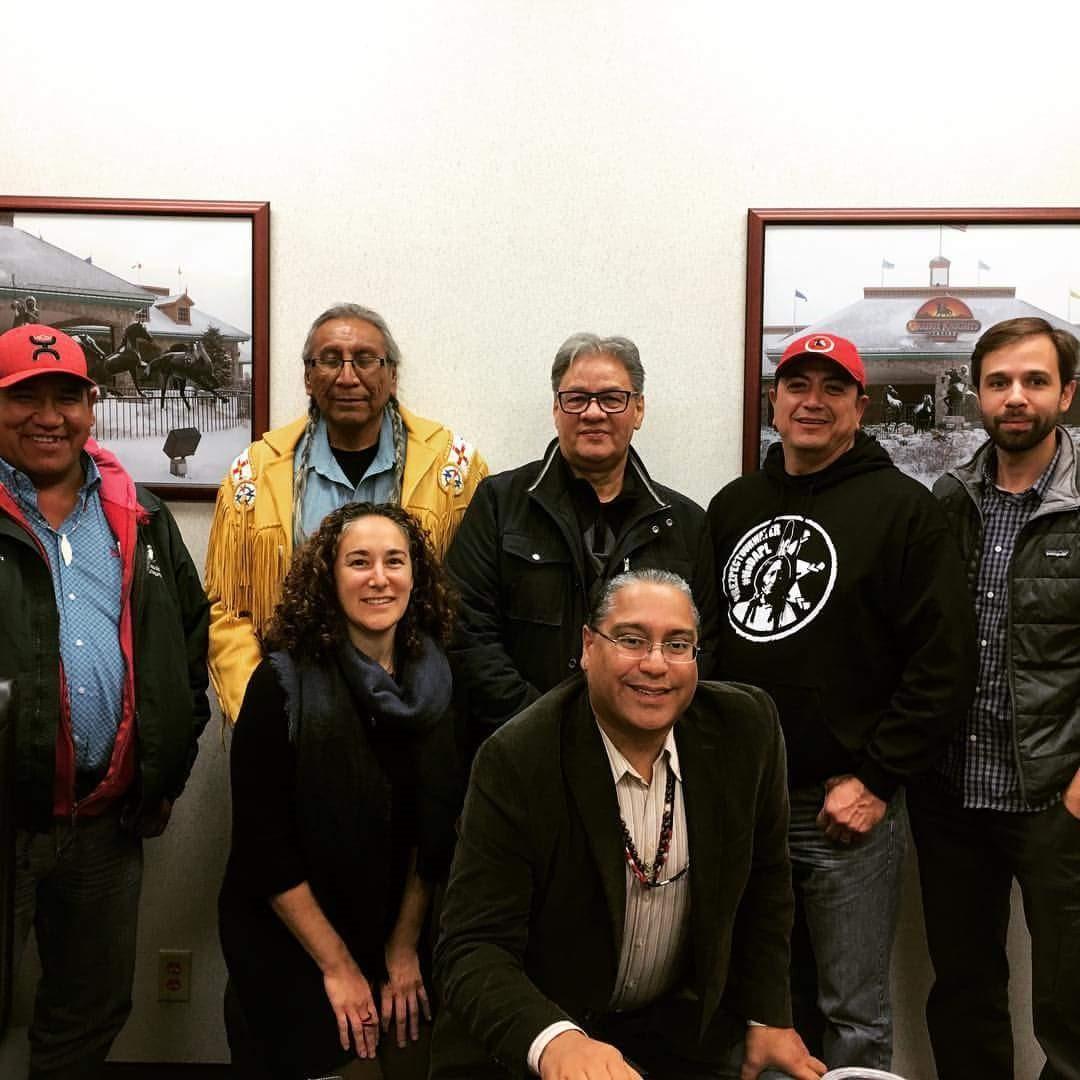
Mission to Standing Rock Sioux Reservation and the Oceti Sakowin (“Seven Council Fires”) Camp, October 29 – 31, 2016
Report submitted by Roberto Borrero representing the International Indian Treaty Council, non-Governmental Organization in General Consultative Status with the Economic and Social Council of the United Nations, traveling as a Human Rights Observer and in support of Grand Chief Edward John, UN Expert Member, Permanent Forum on Indigenous Issues.
Chairman David Archambault II invited Grand Chief Edward John in his official capacity as a UN Expert member of the Permanent Forum on Indigenous Issues to visit the reservation of the Standing Rock Sioux Tribe (SRST) on October 28, 2016 to “observe the critical and worsening human rights crisis situation” taking place in their traditional Treaty lands. This worsening situation results from the continued construction of the Dakota Access Pipeline, which is intended to transport 570,000 barrels of oil per day adjacent to the Standing Rock Sioux reservation. The oil pipeline is also proposed to cross the Missouri River or Lake Oahe, which is the Tribe’s primary source of water, without the consent of or consultation with the Tribe.
This construction is a $3.8-billion-dollar project being carried out by Energy Transfer Partners/Dakota Access LLC, with the support and permission of the US Army Corps of Engineers, and agency of the United States government.
As a representative of the International Indian Treaty Council traveling as a Human Rights Observer, I had the honor of accompanying Grand Chief Edward John on his fact-finding mission to the reservation of the Standing Rock Sioux Tribe on Saturday, October 29 – Monday, October 31st, 2016. The following are my observations from the various meetings and testimonial sessions I participated in over 3 days.
Grand Chief John and I arrived in Bismarck North Dakota on Saturday, October 29th. On this first day of our mission, we met with Standing Rock Sioux Tribal Chairman David Archambault II and Chairman Harold Frazier of the Cheyenne River Sioux Tribe along with other tribal leaders including a representative of the Oglala Lakota from Pine Ridge. Others present at the meeting included IITC Board member Bill Means, Chief Arvol Looking Horse, Glenn Morris, and several tribal members who were involved the incident leading to the arrest of over 100 “water protectors”[1] and local law enforcement that took place October 27, 2016. We were provided with a historic overview of the Standing Rock Sioux Tribe, their Treaties with the US government, and their relationship with the North Dakota State Government. We were head the perspective of the Chairmen regarding what they described as an increasingly tense situation between local law enforcement, the Standing Rock Sioux Tribe and other tribes of the Great Sioux Nation. Chairman Frazier agreed noting that the construction of an oil pipeline near the reservation and set to cross under the Missouri river also directly affects the Cheyenne River Sioux Tribe.
Chairman Archambault also presented the issue of their unceded Treaty lands (currently claimed as Army Corps of Engineers and private property), the destruction of sacred and burial sites, the Tribe’s authority over the river area based on Treaty rights, and long-standing tribal policy against oil extraction on the reservation. Chairman Archambault also noted his consistent calls for the thousands of water protectors who stand in solidarity with the Standing Rock Sioux Tribe against the construction of the Dakota Access Pipeline (DAPL) to “remain in peace and prayer.” He emphasized that “any act of violence hurts their cause and is not welcome.”
At this meeting Tribal members reported on the confrontation between the “water protectors” and local law enforcement from Morton County, the National Guard, DAPL security, and units of militarized police officers from at least 5 other States on October 27, 2016. These personal testimonies were consistent with reports of human rights violations widely shared via social media. One tribal member testified that his son was shot off a horse with "rubber bullets or bean bags." Others reported that during the confrontation in question sacred objects were taken and that several people were pulled from a sweat lodge ceremony.
On Sunday, October 30 Chief John and I visited the Oceti Sakowin camp, which is the largest water protector camp in the area with an estimated total population of several thousands of supports at any given time. There are several other “autonomous” camps sharing the large site, which is considered to be Army Corps of Engineers land, although it was affirmed during our meetings that the Standing Rock Sioux Tribe considers this and the adjacent “private properties” to be unceded Treaty lands belong by law to the Sioux. Another nearby camp, the “Sacred Stone Camp”, is located on the property of a Tribal member Ladonna Brave Bull Allard. We did not have an opportunity to visit this camp.
At the Oceti Sakowin camp, Grand Chief John and I meet with elders, youth and others who were involved in the October 27 incident with local law enforcement. Several water protectors described the clash as a raid by law enforcement on a more recently constructed “north camp.” A steady stream of individuals reported excessive use of force, the mistreatment and confiscation of sacred objects, confiscation of cameras and recording equipment, protectors thrown to the ground when they were not offering resistance, police sitting on the heads of individuals who were on the ground, the firing of tear gas, rubber bullets and bean bag munitions, tasers, concussion grenades by law enforcement. They also reported the arrests of those clearly identified as medics, journalists, and legal observers. They reported harsh confinement conditions and “humiliating” treatment including identification numbers written on their arms. Arrestees reported being held in what they described as "dog kennels.” During their testimonies several individuals displayed the identification numbers written on their arms by police when they were arrested. One woman reported that she was bodily searched by a male officer. Many of those detained reported they were moved to other facilities outside Morton County, sometimes several hours away. A majority of those sharing testimonies also asserted that they were denied the ability to make a phone calls even to contact legal counsel for more than one day, some up to 3 days.
Beyond the incident that took place on October 27th, other individuals reported on the heavy surveillance techniques used by law enforcement around the camp including police vehicles parked near-by on a sacred burial mound, arbitrary arrests, and daily low flying planes and helicopters directly over the camp. Individuals viewed these actions as ongoing harassment techniques by local law enforcement.
In general, those providing testimony consistently expressed that their basic human rights were being consistently violated or abused. In addition, individuals reported on the excessive intimidation tactics used by DAPL Security personal. Several referred to the incident involving their use of attack dogs against water protectors. Some elders, including a counselor in the Veteran’s Association, explained that this tense situation has contributed to or exacerbated the unresolved, historical trauma many indigenous community members deal with daily. They reported that many around the camps were experiencing signs of PTSD. One elder, Faith Spotted Eagle, stated that “outside groups” such as the UN Observers and Amnesty International are “helpful”; however she stated that her view, “they are mostly observing physical results of violations of human rights, and are not able to delve into spiritual/emotional/mental violations and disruption of not only adults, but children.”
On Monday, October 31 Grand Chief John and I met with local law enforcement officials for a briefing in the city of Mandan North Dakota. No media was permitted to attend this meeting. The meeting was arranged by Stephanie Hope Smith, a “Neutral Mediator” registered with North Dakota Court Administrator and led by Cass County Sheriff Paul D. Laney, the head of the joint command. The officials, 9 in all including a political representative of the county, presented an overview of the Thursday, October 27 operation. They reported that, from their perspective, they sought to remove protestors from unlawfully establishing camps on private property. The officials also responded to some questions posed by Chief Ed John and myself. The officials reported that prior to the police actions October 27, they meet with a “camp leader” and informed him that if protestors chose to stay in a more recently established “north camp” they would be arrested. The officials also reported they provided the protestors a full day, on October 26th, to vacate the “north camp”. In defense of the police actions which had been described in very different terms in the protectors’ testimonies, the officials stated that an appropriate use of force was used given the situation. They added that that while there might have been some “minor injuries” during their operation on October 27, there was no loss of life. They denied any violations of human rights or abuse.
The law enforcement officials also stated that on Thursday, October 27th, although police response was “measured” and they “advanced slowly”, protestors threw stones, logs, and malotov cocktails (a simple incendiary weapon) at police and burned at least three vehicles on highway 1806. However, no photos, videos or other forms of evidence were provided to us showing protestors engaging in these specific actions. The officials also reported they took into custody an Indigenous woman who they allege had a firearm and fired at officers. Again, we were not provided with any additional information, evidence or documentation on this specific incident or the woman’s Tribal affiliation. They also reported that approximately 90% of arrests they had made were of individuals from outside North Dakota.
To provide additional background on the situation, the officials reported they have been “dealing with this situation for almost 3 months” and alleged that during that time “protestors have stolen cattle, intimidated local residents, destroyed DAPL property, blocked public highways, and engaged in altercations with police.” Chief John and I were not presented with evidence supporting these allegations. However, the officials reported that over 400 arrests have been made over a period of 3 months. The officials also suggested that there are two contingents at the larger “south camp” including a more radical or militant minority and a larger, more peaceful group.
Morton County Sheriff Kyle Kirchmeier indicated that his department “has nothing to hide” and allowed us to inspect and photograph the "temporary holding cells" (referred to as kennels or dog cages at the camp) located in the garage of the jail facility of the Morton County Sheriff at 205 1st Ave in Mandan, North Dakota. Chief John and I observed that the temporary holding cells included 4 divided cells for men and 2 for women with each unit said to accommodate 25 individuals. The two sets of units are separated by a blue tarp with a distance of about 30 ft between both sets of cells. The temporary holding cells were built over a concrete floor and no mats, no blankets, and no privacy was provided for the detainees. It was reported by the law enforcement officials that detainees were asked to remove their shoes and “strip down to one layer of clothing” and were held in these cells. The temporary holding cells were built by a local fencing company and according to officials, approved by the State Department of Corrections (see addendum). Two portable washrooms, one marked male and the other female, are located in the same space in the garage. This is where the individuals were processed. From this location, due to limited space in the Morton County jail facilities, individuals were then transported to other jail facilities - some as far as 400 miles away.
This same day, October 31st 2016, I returned to the Oceti Sakowin camp and I participated in a report and briefing to the water protectors at the camp regarding the visit of UN Expert Member, Grand Chief Edward John of the Permanent on Indigenous Issues. My statements highlighted the invitation from Chairman Archambault and the process Chief John and I followed over the 3 days of our visit.
In conclusion, in my personal view, this is a complex situation involving and highlighting State, Federal and Tribal jurisdictional issues. There is a need for immediate, direct, active and meaningful Nation-to-Nation dialogue with the United States Federal Government including the US Army Corps of Engineers, the Department of Justice, the US State Department and other relevant US agencies and the Tribal Government of the Standing Rock Sioux and other affected Tribes, based on US human and Treaty rights obligations. Despite the US Treaty and Trust responsibilities and their direct involvement through the Army Corps of Engineers, the active presence of the US Federal government on site to resolve the crisis and uphold the rights of the Tribe is notably absent. In addition, the ongoing unresolved territorial and Treaty rights issues and the lack of adherence by the pipeline company (Dakota Access and its Texas-based parent company Energy Transfer Partners) to the Federal Government’s calls (in September and October 2016) for a voluntary work halt are exacerbating the crisis and contributing to the growing tensions and frustrations in and around the Oceti Sakowin and other camps.
The situation I witnessed and testimonies I heard support and reaffirm the original concerns expressed in the August 18, 2016 joint urgent action submission by the Standing Rock Sioux Tribe and the International Indian Treaty to 4 UN mandate holders and also cc’d to US government officials (see link in addendum). What we saw and heard on our visit validates the ongoing and in some cases worsening human rights concerns expressed in that submission as well as a subsequent one sent on September 4th that focused on growing repression by private security and public law enforcement.
For the most part during our visit, testimony was presented orally and those providing testimony specified whether they wished for their names to appear in the public report or that their identity should be protected for fear of reprisal. It was also understood that these testimonies would be presented publicly, with or without names, to specific mandate holders within the United Nations System.
Chief John and I have some video footage, but it remains to be determined how this footage can be used in accordance with the wishes of the Tribe and the participants. In addition, the Standing Rock Sioux Tribe assigned a photographer to us, however, not all photos was provided to us before our departure.
Finally, both Grand Chief John and I were well-received by the officials of the Standing Rock Tribe, the water protectors of the various camps, spiritual leaders, as well as the North Dakota law enforcement officials. Many water protectors expressed their personal thanks for our visit. Elders and spiritual leaders remarked how our visit lifted peoples’ spirits and was greatly appreciated by all.
Addendum:
1.) A message from Michelle L. Linster, Public Information Officer
North Dakota DOCR (Department of Corrections and Rehabilitation):
The North Dakota Department of Corrections and Rehabilitation (DOCR) has approved the temporary fenced cubicles and at this time all the essential services are being provided to those placed in the temporary fenced cubicles. The DOCR will continue to monitor the usage of these temporary fenced cubicles."
"Temporary holding cells (chain link fences) have been installed into the Morton County Correctional Center and are used for mass arrest" situations only. They are temporary until the Correctional Center can get them processed into our facility or transferred to another facility in North Dakota. The temporary housing units have been inspected and approved by the ND Department of Corrections which has oversight over all county correctional centers in ND. While there they have access to bathroom facilities, meals and drinking water. If any medical situations arise they are addressed by a medical or nursing staff on site. Morton County Correctional Center has room for only 42 inmates and during a mass arrest arrangements have been made to transport to other jails. When a person is arrested and arrives at the jail, trained staff conduct a visual assessment, are patted down when they are admitted, and all items and property are collected and placed in a bag which is returned when they leave."
2.) Standing Rock Sioux Tribe and IITC Urgent Communication to United Nations, August 18, 2018:
[1] “Water protectors” is the preferred name of those who are gathered to support the SRST in their opposition to the current DAPL construction, rather than “protesters” as referenced by police
Photo: Meeting on the Standing Rock Sioux Reservation, From L to R: Chairman Harold Fraizer; Chief Arvol Looking Horse; Alyssa Johyl; Grand Chief Edward John; Roberto Mukaro Borrero; Chairman Dave David Archambault II; Baskut Tuncak, Special Rapporteur on Human Rights and Toxins in his personal capacity (photo provided via Baskut Tuncak, October 29, 2016.



